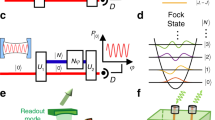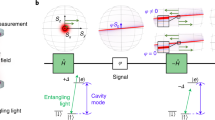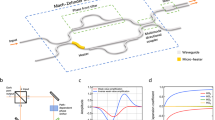Abstract
Amplifiers are crucial in every experiment carrying out a very sensitive measurement. However, they always degrade the information by adding noise. Quantum mechanics puts a limit on how small this degradation can be. Theoretically, the minimum noise energy added by a phase-preserving amplifier to the signal it processes amounts at least to half a photon at the signal frequency. Here we propose a practical microwave device that can fulfil the minimal requirements to reach the quantum limit. The availability of such a device is of importance for the readout of solid-state qubits, and more generally for the measurement of very weak signals in various areas of science. We discuss how this device can be the basic building block for a variety of practical applications, such as amplification, noiseless frequency conversion, dynamic cooling and production of entangled signal pairs.
This is a preview of subscription content, access via your institution
Access options
Subscribe to this journal
Receive 12 print issues and online access
$209.00 per year
only $17.42 per issue
Buy this article
- Purchase on Springer Link
- Instant access to full article PDF
Prices may be subject to local taxes which are calculated during checkout




Similar content being viewed by others
References
Shimoda, K., Takahasi, H. & Townes, C. H. Fluctuations in amplification of quanta with application to Maser amplifiers. J. Phys. Soc. Jpn 12, 686–700 (1957).
Haus, H. A. & Mullen, J. A. Quantum noise in linear amplifiers. Phys. Rev. 128, 2407–2413 (1962).
Caves, C. M. Quantum limits on noise in linear amplifiers. Phys. Rev. D 26, 1817–1839 (1982).
Tien, P. K. Parametric amplification and frequency mixing in propagating circuits. J. Appl. Phys. 29, 1347–1357 (1958).
Louisell, W. H. Coupled Mode and Parametric Electronics (John Wiley, 1960).
Louisell, W. H., Yariv, A. & Siegman, A. E. Quantum fluctuations and noise in parametric processes. I. Phys. Rev. 124, 1646–1654 (1961).
Gordon, J. P., Louisell, W. H. & Walker, L. R. Quantum fluctuations and noise in parametric processes. II. Phys. Rev. 129, 481–485 (1963).
André, M.-O., Mück, M., Clarke, J., Gail, J. & Heiden, C. Radio-frequency amplifier with tenth-kelvin noise temperature based on a microstrip direct current. Appl. Phys. Lett. 75, 698–700 (1999).
Spietz, L., Irwin, K. & Aumentado, J. Input impedance and gain of a gigahertz amplifier using a dc superconducting quantum interference device in a quarter wave resonator. Appl. Phys. Lett. 93, 082506 (2008).
Yurke, B. et al. Observation of parametric amplification and deamplification in a Josephson parametric amplifier. Phys. Rev. A 39, 2519–2533 (1989).
Yurke, B. Observation of 4.2-K equilibrium-noise squeezing via a Josephson-parametric amplifier. Phys. Rev. Lett. 60, 764–767 (1988).
Movshovich, R. et al. Observation of zero-point noise squeezing via a Josephson-parametric amplifier. Phys. Rev. Lett. 65, 1419–1422 (1990).
Wallraff, A. et al. Strong coupling of a single photon to a superconducting qubit using circuit quantum electrodynamics. Nature 431, 162–167 (2004).
Lupaşcu, A. et al. Quantum non-demolition measurement of a superconducting two-level system. Nature Phys. 3, 119–125 (2007).
Mika, A., Sillanpää, M. A., Park, J. I. & Simmonds, R. W. Coherent quantum state storage and transfer between two phase qubits via a resonant cavity. Nature 449, 438–442 (2007).
Majer, J. et al. Coupling superconducting qubits via a cavity bus. Nature 449, 443–447 (2007).
Castellanos-Beltran, M. A. & Lehnert, K. W. Widely tunable parametric amplifier based on a superconducting quantum interference device array resonator. Appl. Phys. Lett. 91, 083509 (2007).
Castellanos-Beltrana, M. A., Irwin, K. D., Hilton, G. C., Vale, L. R. & Lehnert, K. W. Amplification and squeezing of quantum noise with a tunable Josephson metamaterial. Nature Phys. 4, 928–931 (2008).
Tholeń, E. A. Nonlinearities and parametric amplification in superconducting coplanar waveguide resonators. Appl. Phys. Lett. 90, 253509 (2007).
Yamamoto, T. et al. Flux-driven Josephson parametric amplifier. Appl. Phys. Lett. 93, 042510 (2008).
Zhang, Q., Ruskov, R. & Korotkov, A. N. Continuous quantum feedback of coherent oscillations in a solid-state qubit. Phys. Rev. B 72, 245322 (2005).
Korotkov, A. N. Simple quantum feedback of a solid-state qubit. Phys. Rev. B 71, 201305 (2005).
Pozar, D. M. Microwave Engineering 629 (Wiley, 2005).
Devoret, M. H. Quantum Fluctuations: Les Houches Session LXIII (Elsevier, 1997).
Yurke, B. & Denker, J. S. Quantum network theory. Phys. Rev. A 29, 1419–1437 (1984).
Caldeira, A. O. & Legget, A. J. Quantum tunneling in a dissipative system. Ann. Phys. 149, 374–456 (1983).
Mears, C. A Quantum-limited heterodyne detection of millimetre waves using superconducting tantalum tunnel junctions. Appl. Phys. Lett. 57, 2487–2489 (1990).
Wahlstein, S., Rudner, S. & Claeson, T. Arrays of Josephson tunnel junctions as parametric amplifiers. J. Appl. Phys. 49, 4248–4263 (1979).
Mygind, N., Perdersen, F., Soerensen, O. H., Dueholm, B. & Levinsen, M. T. Low-noise parametric amplification at 35 GHz in a single Josephson tunnel junction. Appl. Phys. Lett. 35, 91–93 (1979).
Bryant, P., Wiesenfeld, K. & McNamara, B. Noise rise in parametric amplifiers. Phys. Rev. B 36, 752–755 (1987).
Bjork, G. & Yamamoto, Y. Generation of nonclassical photon states using correlated photon pairs and linear feedforward. Phys. Rev. A 37, 4229–4239 (1984).
Grosshans, F. & Grangier, P. Continuous variable quantum cryptography using coherent states. Phys. Rev. Lett. 88, 057902 (2002).
Siddiqi, I. et al. RF-driven Josephson bifurcation amplifier for quantum measurement. Phys. Rev. Lett. 93, 207002 (2004).
Metcalfe, M. et al. Measuring the decoherence of a quantronium qubit with the cavity bifurcation amplifier. Phys. Rev. B 76, 174516 (2007).
Guillemin, V. & Sternberg, S. Symplectic Techniques in Physics (Cambridge Univ. Press, 1984).
Acknowledgements
This work was supported by NSA through ARO grant number W911NF-05-01-0365, the Keck foundation and the NSF through grant number DMR-032-5580. M.H.D. acknowledges partial support from College de France. We are indebted to B. Abdo for help with the proof corrections.
Author information
Authors and Affiliations
Contributions
M.H.D. proposed the original idea of the ring modulator. N.B. and M.H.D. developed the device, carried out the theoretical analysis and wrote the article. R.V., V.E.M. and I.S. contributed extensively to discussions of the results. S.M.G. introduced all authors to the multifunctional aspect of three-wave mixing. R.J.S. contributed by his knowledge of ultralow-noise microwave circuits and measurements.
Corresponding authors
Ethics declarations
Competing interests
The authors declare no competing financial interests.
Supplementary information
Supplementary Information
Supplementary Information (PDF 156 kb)
Rights and permissions
About this article
Cite this article
Bergeal, N., Vijay, R., Manucharyan, V. et al. Analog information processing at the quantum limit with a Josephson ring modulator. Nature Phys 6, 296–302 (2010). https://doi.org/10.1038/nphys1516
Received:
Accepted:
Published:
Issue Date:
DOI: https://doi.org/10.1038/nphys1516
This article is cited by
-
High-fidelity parametric beamsplitting with a parity-protected converter
Nature Communications (2023)
-
Realizing all-to-all couplings among detachable quantum modules using a microwave quantum state router
npj Quantum Information (2023)
-
Quantum advantage in microwave quantum radar
Nature Physics (2023)
-
A Review of Developments in Superconducting Quantum Processors
Journal of the Indian Institute of Science (2023)
-
Photon-pressure strong coupling between two superconducting circuits
Nature Physics (2021)



